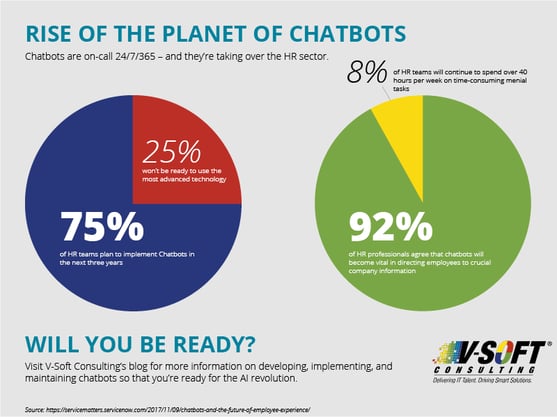With HR roles transforming from passive to active strategic business partner, it is not easy to solve the challenges of a successful HR Automation plan, while maintaining a human approach. With the Artificial Intelligence ability in streamlining various business functions for the HR professional is provided the capacity to deliver innovative solutions to solve HR challenges and deliver a better experience. Here are just some of the ways AI is transforming HR to be a more powerful strategic business partner in any company.
33% of surveyed HR teams are using some form of artificial intelligence (AI) technology to deliver HR solutions, and 41% are actively building mobile apps to deliver HR service."
2017 Deloitte Global Human Capital Trends
Better Communication Management
Even while having a self-assisting HR portal, employees still send emails to HR asking for some information. Getting the solution for these emails requires sending emails back-and-forth. This repetitive communication still takes close to 70 percent of HR support time according to recent studies.
Having an AI-powered HR Chatbot the HR team can take the employee requests 24/7 and resolve them immediately. In addition to processing employee requests, companies can take feedback on various policies on a regular basis for delivering a better workplace. The best part of chatbot technology is that chatbots enable the employees to interact live in their natural language and receive responses with a human touch.
(To know how HR automation can quicken the onboarding process, check out this case study brief .)
This bi-directional communication process can increase the employee engagement and satisfaction levels. In turn, can bring down the employee turnover at a rate of over 15 percent.

Predictive Analytics for Better Workforce Management
The quest for the organizations to globalize their businesses and services has increased beyond leaps and bounds. In these prospects, the key to success is efficient workforce; moreover, the workforce is the key competitive edge. In this regard, HR strategies have been focusing all their efforts on getting the right talent for the right role and tune the talent in line with the organizational objectives. In fact, it is the right talent that delivers better productivity.
With increasing numbers of employees, the ability to manage and analyze workforce data becomes difficult. HR teams need to run workforce analytics with various metrics on each employee to gather precisely the data about the KPI's like skill gaps, strengths, learning patterns, and performance gaps, employees are facing. Here, applying AI solution-predictive analytics- would identify the problems halting the employee to progress and suggests solutions (like training sessions,) to fine-tune the performance aspects.
Usually, companies only conducting this process once or twice in a year, may not yield the best results. Implementing predictive analytics, which would run the process for each employee on a regular basis and give timely suggestions to the employees, can improve results. This builds the morale of the employees and delivers better employee satisfaction and engagement thereby helping the HR teams to manage the workforce better and to build the future-ready workforce.
Fully Automated and Interactive Onboarding
The employee onboarding process is often the most difficult job for HR teams. To reduce these difficult tasks, a cloud-based HR automation solution, HR portal, may be implemented which becomes an integral part of the onboarding process.
This cloud-based HR automation solution, HR portal, can be made even more effective by adapting an HR onboarding chat application. This HR chatbot can guide the employee to fill the information step-by-step in more humane and live interaction ways. Also, if employees have further doubts, these can be clarified by the bot itself, instead of a human HR. This way, the chatbot application can bring better automation with a more human touch. Most importantly this leaves the HR team available for more critical tasks, including strategy and employee problem escalations.
















